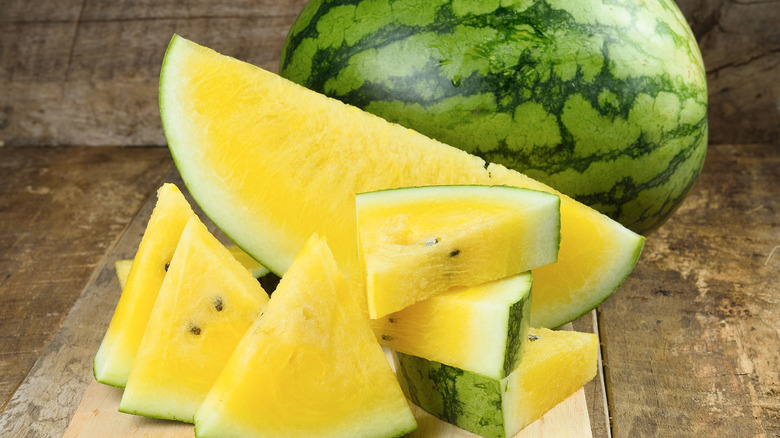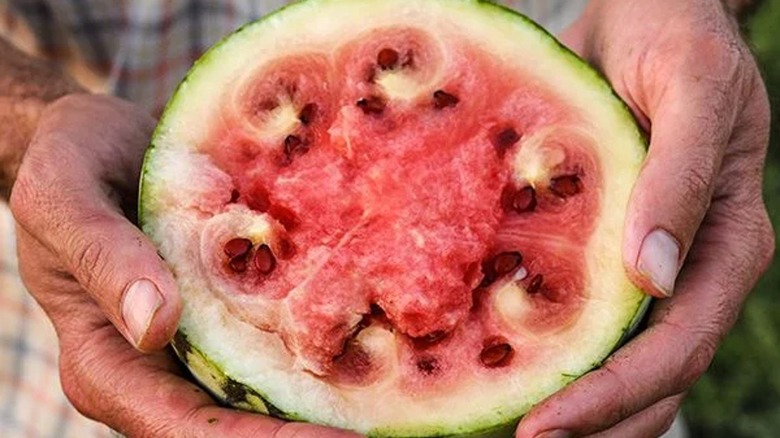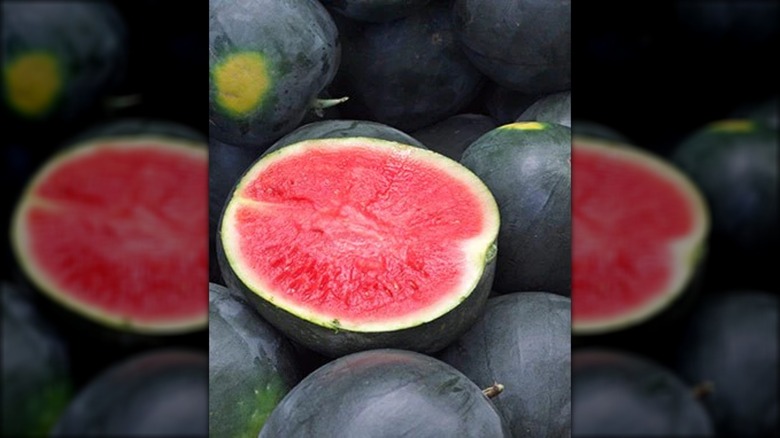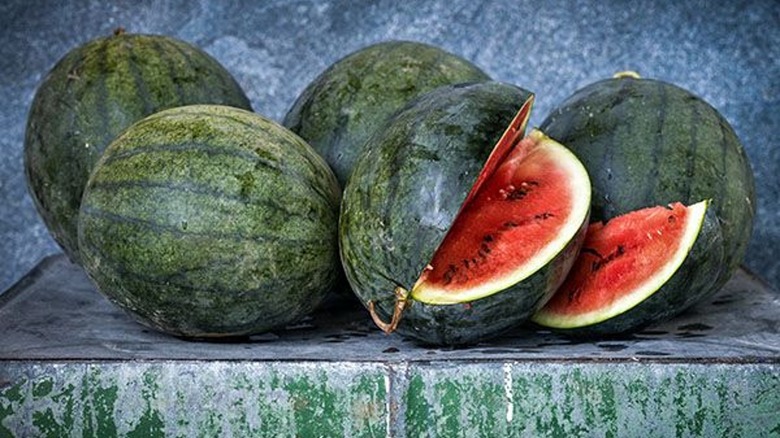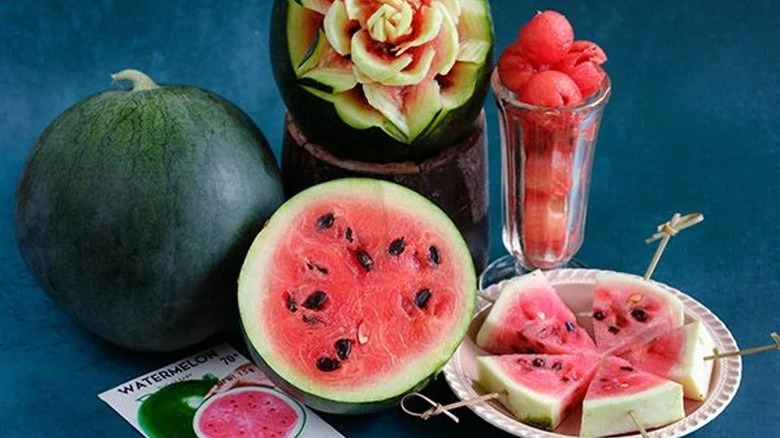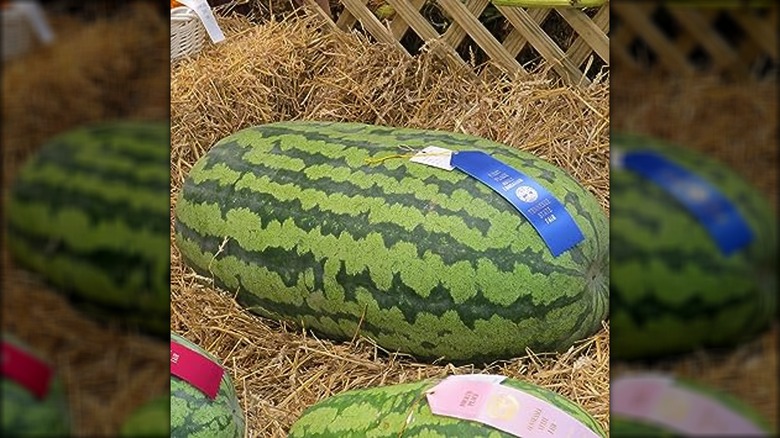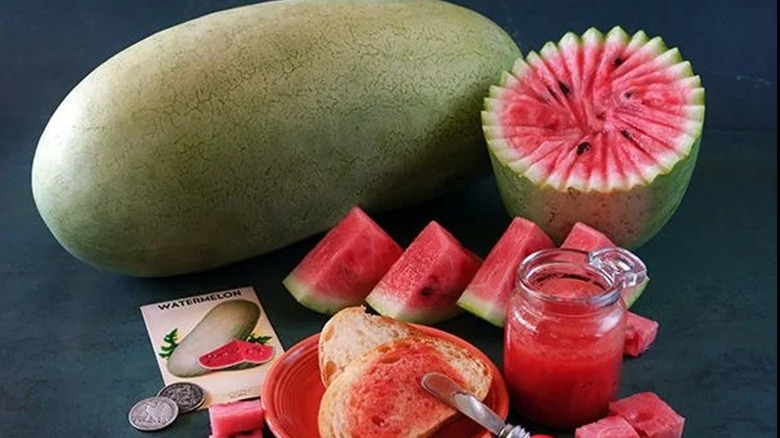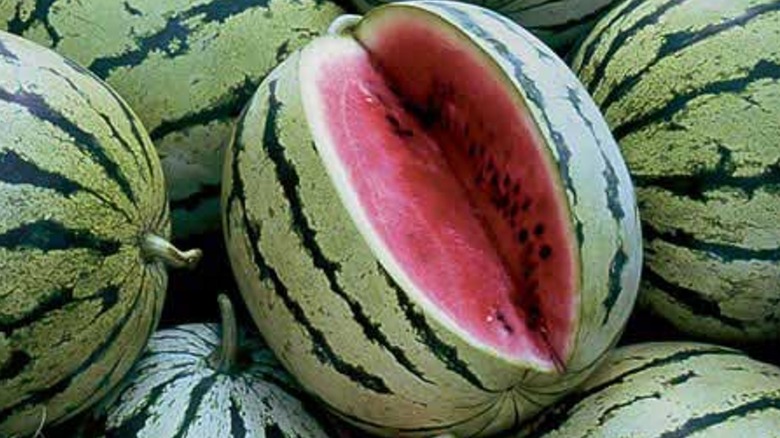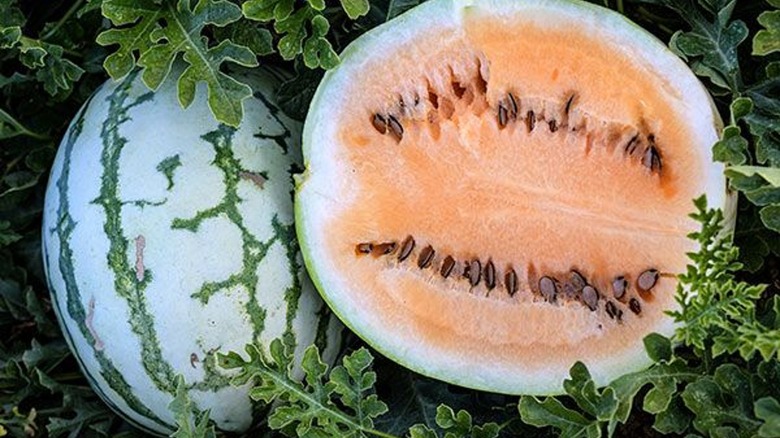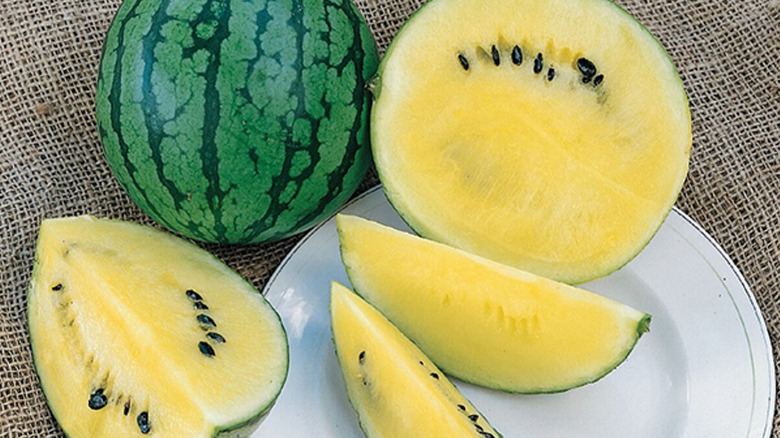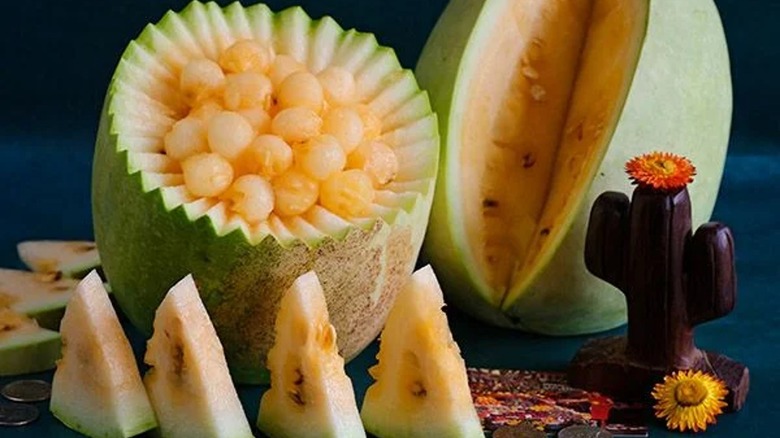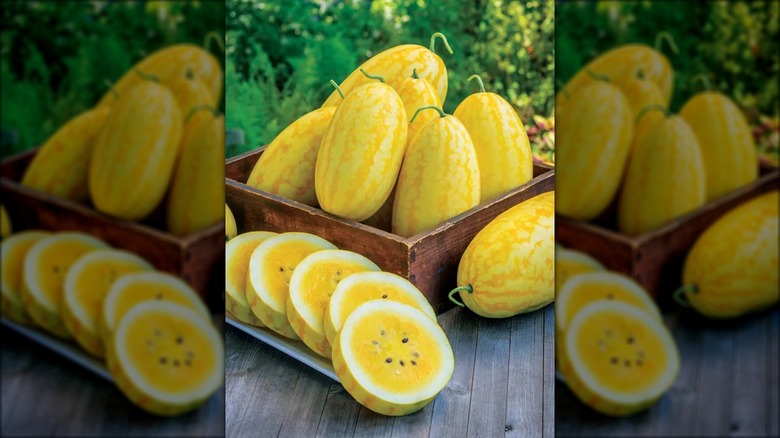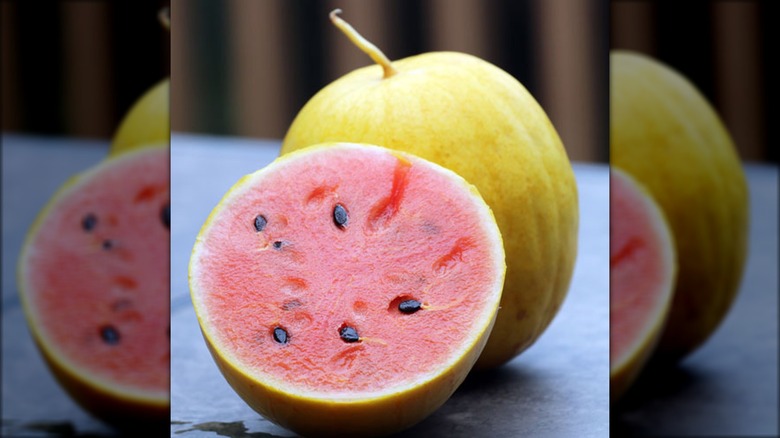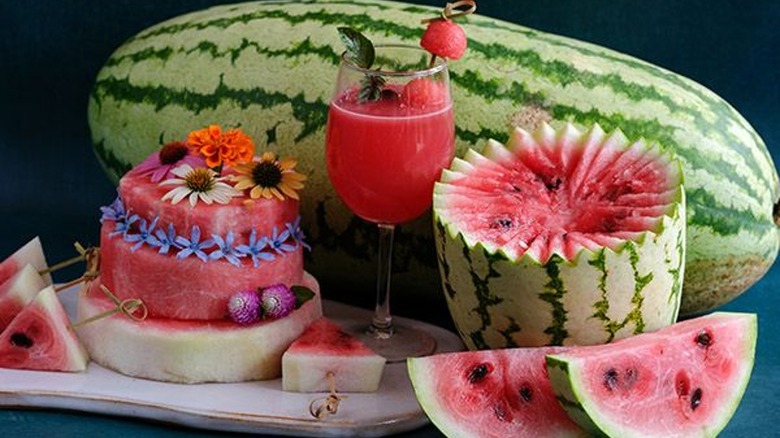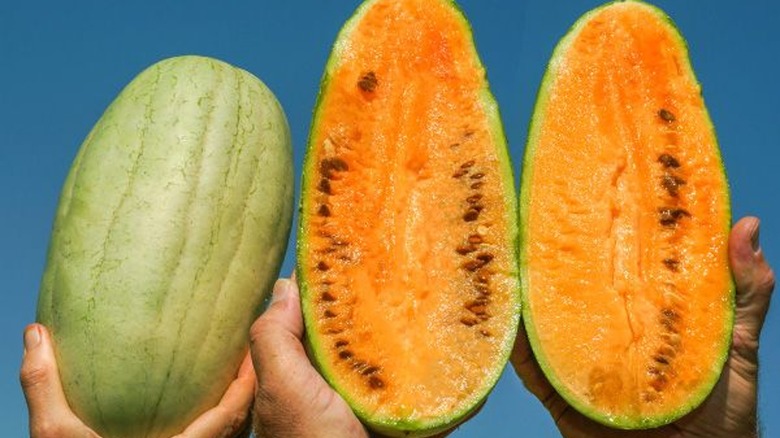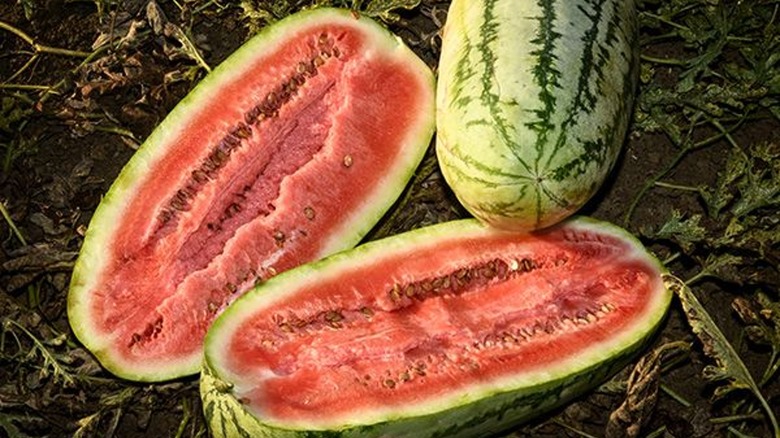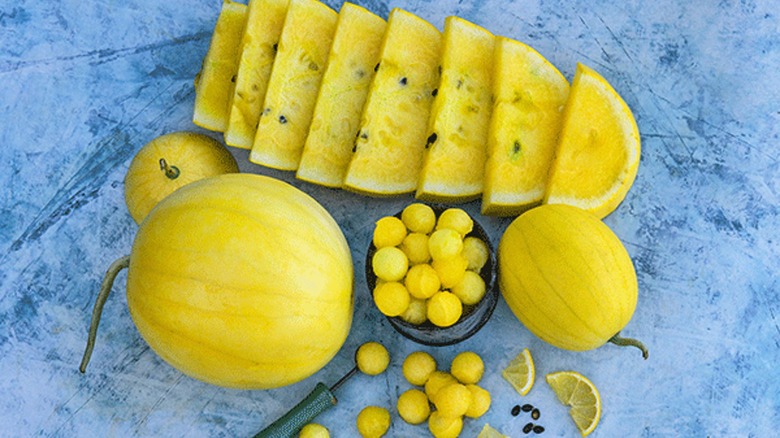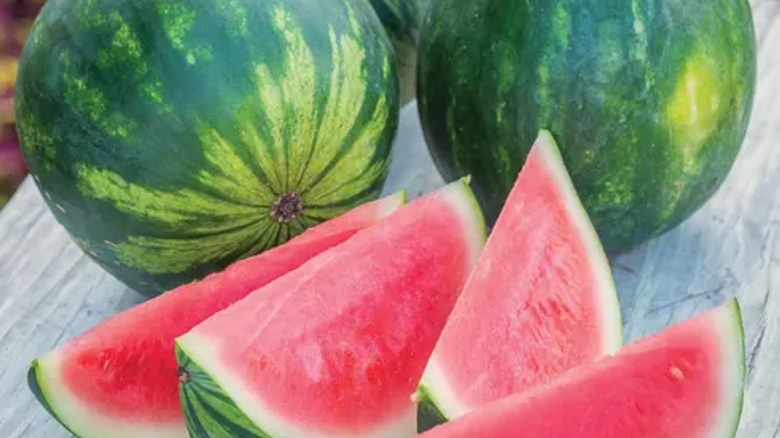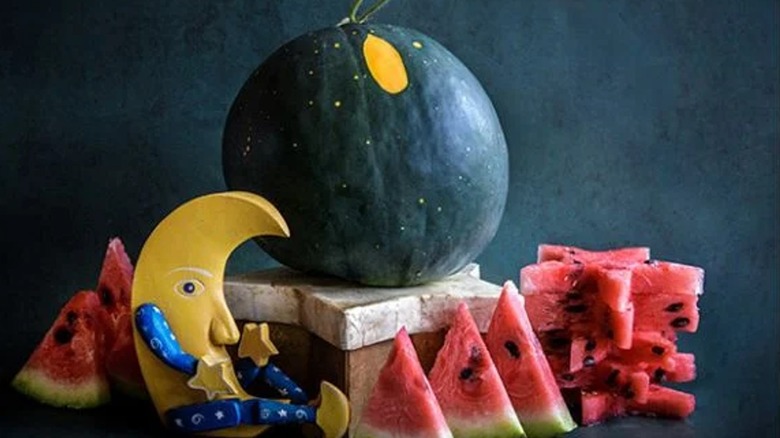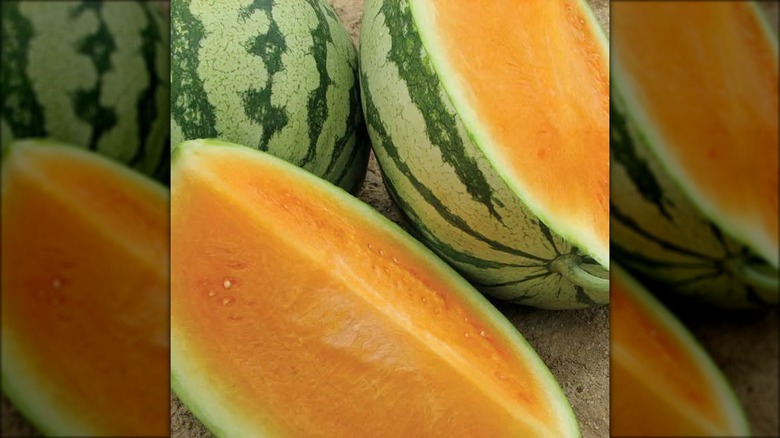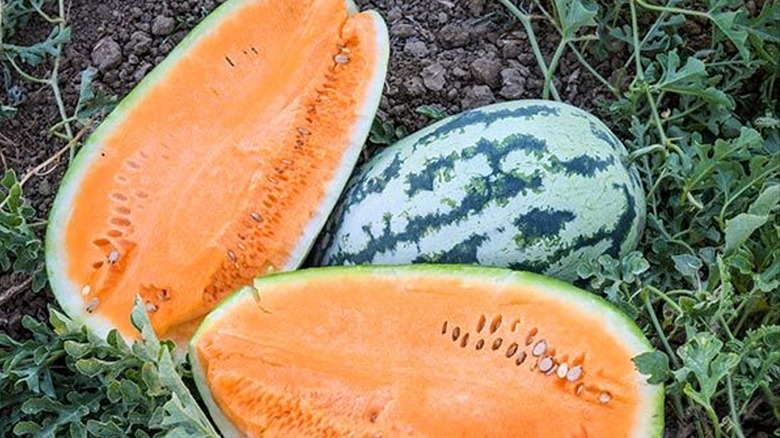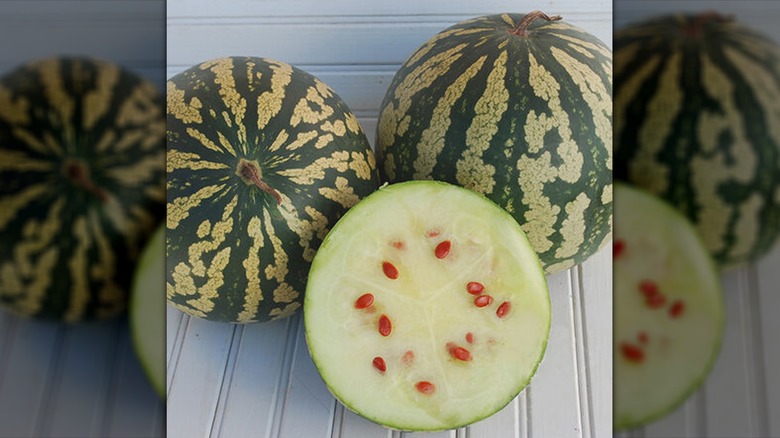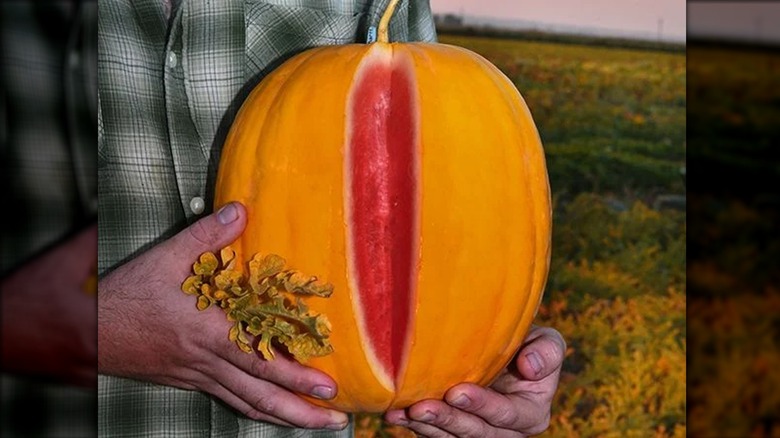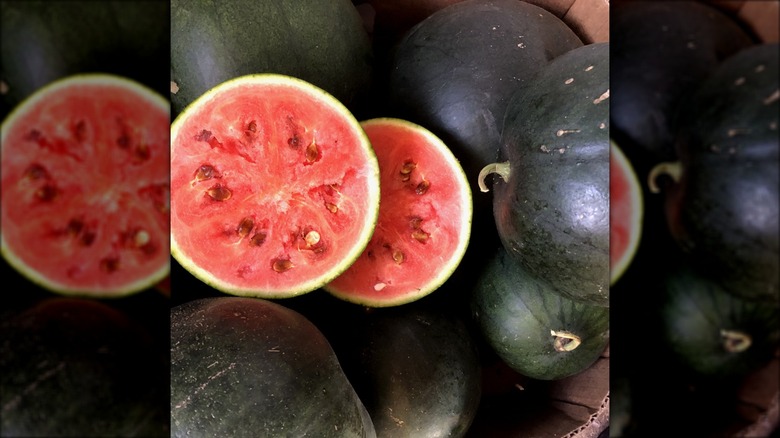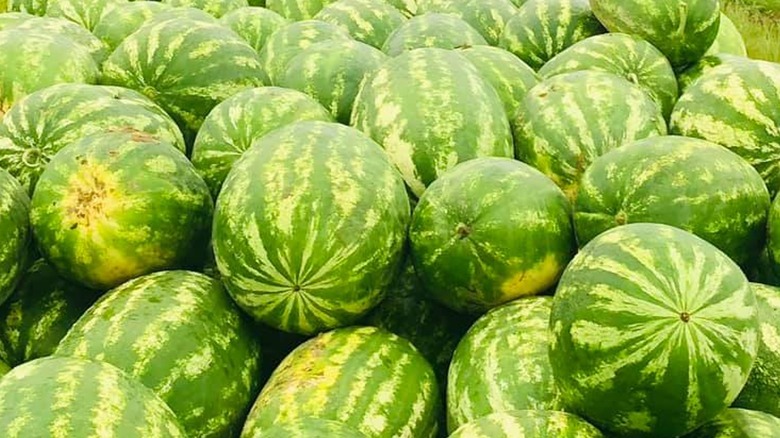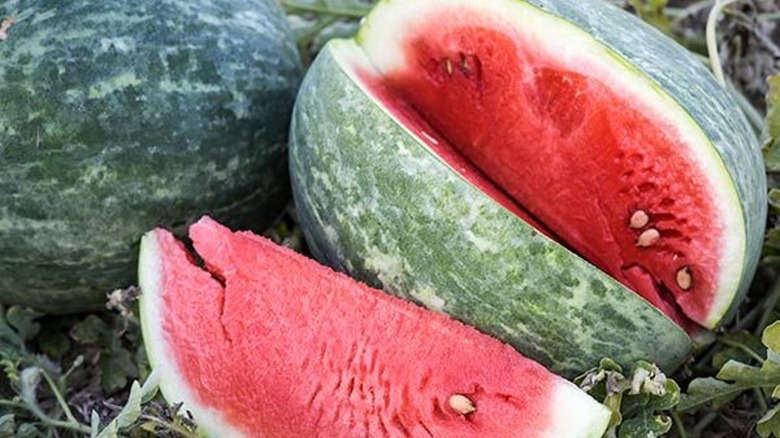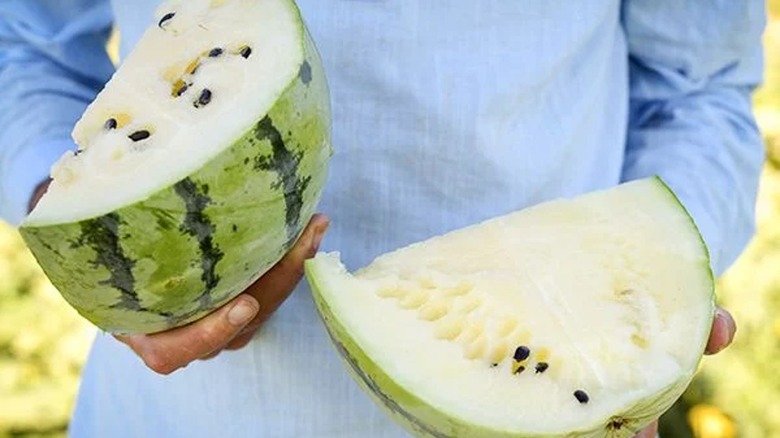26 Watermelon Varieties You Didn't Know Existed
If you've lived your life only eating classic striped watermelons with red flesh, you've been missing out on so many varieties. While you may not find out-of-the-ordinary watermelon types at your local grocery store, you should watch for them at the farmer's market. If all else fails, you can buy a package of seeds and plant a breed that intrigues you in your backyard. While we've included a 200-pound melon on our list, some are small enough to plant running up a trellis off the ground.
We've found 26 types of watermelon that you've likely never seen or heard of before. Their exteriors come in unusual shades from black to yellow and orange, with curious insides that range from white to yellow and orange. While most of these are easy to obtain as seeds, you may have to take a road trip to experience others at their natural source.
1. Beni Kodama watermelon
Beni Kodama watermelons are fun and personal-sized, so they don't take up much space in your fridge or garden. At only 2 or 3 pounds, you can even grow them on a trellis. Beni Kodamas come from Japan and prefer temperatures between 70 and 95 degrees Fahrenheit. Since these tiny melons only take 60 days to mature, you'll be able to eat them sooner than larger varieties.
The red-fleshed fruit is decorated with beautiful whorls and lots of seeds. Another unique feature about these melons is that the rind is sometimes sweet even though the color might not suggest it.
2. Black Diamond watermelon
Although Black Diamond watermelons aren't a true black color on the outside, they're extremely dark green, which makes a striking contrast with their bright red flesh. These heirloom watermelons first came on the scene when Melville Dillon created them in Arkansas in the 1940s.
Black Diamonds tend to weigh somewhere between 35 and 100 pounds. So, you'll potentially need a lot of garden space and a few extra mouths to finish one off. The trick is to pick them the moment they're sweet without waiting until the middle is overripe. You'll know they're ripe when the bottom is pale yellow and the rest is dark green.
3. Blacktail Mountain watermelon
Glenn Drowns started experimenting with breeding the Blacktail Mountain watermelon in Idaho in the 1970s when he was only 17, but it took him a few more years to finish developing it. You'll probably want to eat this fruit in the bathtub since it's a whopping 95% water. Its liquid content makes it perfect for refreshing drinks like watermelon lemonade. Despite the high water content, it still manages to be pleasantly sweet.
This 6- to 12-pound fruit fares well in colder climates, and can handle nights that get down as low as 40 degrees Fahrenheit. This means it will keep producing into the fall long after other plants are done.
4. Bush Sugar Baby watermelon
Bush Sugar Baby watermelons only grow to about 12 pounds on a 3.5-foot vine, which makes them a good candidate for small gardens and refrigerators. This variety is one of the sweetest watermelons around and has a delightfully crisp, smooth flesh. It only takes about 75 days for the fruit to ripen, so you can eat it only a couple of months after planting.
If you end up turning these into a dessert like watermelon sorbet or watermelon pie, it's probably not a bad idea to adjust the overall sugar content of the recipe since the fruit is so sweet. However, it's so tasty alone that you may not want to waste it on dessert.
5. Carolina Cross #180 watermelon
If you ever grow or buy a Carolina Cross #180 watermelon, you're in for a whopper. These melons are known for being huge, with some reaching over 200 pounds. You're going to want to plan a feast and research ways to use up leftover watermelon before you break open one of these babies. They're also a great option if you're trying to win a competition at a state fair.
Many people start the seeds indoors since it takes around 110 days for these enormous watermelons to ripen. Luckily, the red flesh is crisp and full of flavor, so it's worth the wait.
6. Charleston Gray watermelon
Did you know some fruits can get sunburned? Luckily, Charleston Gray watermelons never have to worry about that because their grayish-green coloring protects them from the sun. As you may be able to guess from their name, they originated in Charleston, South Carolina. Charles Andrus developed this variety in 1954 while trying to create melons that were resistant to certain types of fungus and disease. So, these are tenacious fruits in more ways than one.
Charleston Grays are bright red on the inside, contrasting beautifully with their gray interiors. They weigh 25 to 35 pounds and delight watermelon lovers with their sweet flavor and crisp, fiberless texture.
7. Chris Cross watermelon
The Chris Cross watermelon was the slowly-birthed brainchild of Chris Christensen. In 1940 he set out to cross-breed the long, black-seeded, disease-resistant Hawkesbury watermelon with the oval-shaped, white-seeded, redder-fleshed Dixie Queen. He was aiming for a prettier melon like the Dixie Queen that had the disease resistance and black seeds of the Hawkesbury. By 1950, he had created perfection, and farmers were demanding the seeds.
The resulting 15- to 20-pound melon is gorgeous and has the perfect level of sweetness. It has a classic look, with bright red flesh, black seeds, and a light and dark green striped oval-shaped exterior.
8. Clay County Yellow Meat watermelon
Clay County Yellow Meat watermelons have their own festival. If you're anywhere near Ashland, Alabama, in August, you'll want to head down to the annual Clay County Alabama Yellow Meated Watermelon Festival. It features lots of these yellow beauties straight from the field, along with plenty of yellow-water-melon-themed goods.
These sweet melons first started delighting Alabama residents in the early 1900s. While they look like ordinary red-fleshed melons on the outside, a surprising orange-yellow-colored flesh and tan seeds await you on the inside. Despite being a different color, the taste is very similar to a classic red variety.
9. Cream of Saskatchewan watermelon
Cream of Saskatchewan watermelons look unripe on the inside, but don't let the light yellow to white-colored flesh fool you. After 75 to 85 days of growth, they'll be sweet and tasty even if the flesh is still white. This variety has been in North America since Russian immigrants brought them to Saskatchewan, Canada, in the early 1900s.
They're perfect for colder climates, only grow to be 5 to 10 pounds, and don't take up much space. Since they have a thin rind, they're also more delicate than you might expect. However, the light flesh doesn't stand in the way of the fruity sweet flavor.
10. Desert King watermelon
The Willhite Seed Watermelon breeders developed the Desert King watermelon in the 1960s. Being in Texas, they were trying to create a variety that could withstand the state's blistering sun and heat. While it does need water, the Desert King is more drought-tolerant than other types. Its light-colored rind is also sunburn resistant, and it prefers to grow in warmer soil (around 70 to 95 degrees Fahrenheit).
This mighty melon weighs in at 20 to 30 pounds and has a yellow-colored flesh that's nearly orange. Despite the light-colored skin and flesh, you can expect a juicy flavor that is reminiscent of your best memory of the fruit.
11. Gold in Gold Hybrid watermelon
No, nothing is wrong with these watermelons — they're simply golden inside and out. Gold in Gold Hybrid watermelons have thick, light yellow skin with golden stripes. Despite its diluted coloring, you may be surprised to learn that Gold in Gold is sweeter than most red melons. It has a crisp and juicy texture that won't disappoint.
You can't mistake them for any other type of melon aside from Red in Golds which look the same on the outside but have red flesh on the inside instead. This variety grows to be between 11 to 16 pounds, making it easy to store and serve.
12. Golden Midget watermelon
Golden midgets remind us of small yellow pumpkins on the outside. But, once you cut into them, you'll find a surprising salmon-colored interior that looks almost red against the gold. Golden Midget watermelons are only likely to get up to 3 pounds, so they're usually among the first ripe melons available.
Growing these can be a little difficult, as you have to watch that other animals don't plunder them before they're ready to pick. Sometimes, these end up nearly flavorless, while other times they end up sweet with a classic flavor. Regardless, they're juicy, crisp, and quite tasty.
13. Jubilee watermelon
The Jubilee watermelon has been a favorite since the Florida Agricultural Experiment Station (FAES) in Leesburg, Florida, created it in 1963. It has a classic green-striped exterior and a pinkish-red interior. Beyond being a tasty, sweet melon in the 25- to 40-pound range, the FAES created it to be resistant to fusarium wilt and anthracnose.
It takes 97 days for Jubilees to mature and be ripe enough to eat, but the wait is worth it. When they're ready, you'll find them sweet, juicy, and crisp. Since they're large and consistently delicious, they've been a favorite of watermelon growers and consumers for decades.
14. Kaho watermelon
Kaho watermelons are odd-looking and have small, elongated bodies and bright or light orange flesh that sets them apart. They only weigh 2 to 4 pounds each, so they're fun to split with a friend. This variety originated in China and made its way to Japan around 1912.
While Kahos are juicy, they're not overly sweet, except in hotter temperatures when the fruit sugars are especially high. They're a good candidate to grow on a trellis since they're only slightly larger than a big cucumber. Since they're so small and the skin is so thin, growing them off the ground will help protect them from hungry animals and pests.
15. Kurobe watermelon
Rattlesnake watermelons arrived in Japan sometime in the late 1800s or early 1900s. However, it was only in the 1930s that people living near the Kurobe River started to cultivate them into today's Kurobe watermelons (or Nyuzen Jumbo watermelons). Because of their popularity, they sell for around $50 and come in a special loose rope basket with a handle for easier transport. Growers offer one to the royal Japanese family on a yearly basis.
Kurobes weigh between 37 and 41 pounds, which is twice as big as ordinary Japanese watermelons. Their size and capacity to serve many people make them a hit at summer festivals. Of course, these traditional-looking melons wouldn't be so popular if they didn't also taste delicious.
16. Lemon Drop watermelon
You're not likely to find Lemon Drops for sale anywhere except at farmer's markets since the thin skins make them too fragile for shipping. In fact, they often split open on the vine, so they're quite finicky to grow.
Their name refers both to their bright yellow, lemon-like color and their flavor, which is sweet with a slight citrus undercurrent. One unique attribute of Lemon Drop watermelons is that their flavor extends from the yellow flesh through to the white of the inner rind. They're also only 1 to 2 pounds, so they're practically pre-portioned for an individual serving.
17. Mini Piccolo watermelon
Mini Piccolo watermelons are not only small, but they're also seedless. So, if you're looking for tiny, sweet, juicy melons without the inconvenience of seeds, this is a great choice. The variety is a hybrid that has been bred to the point of being sterile. This means the fruit requires seeded watermelon companion plants in the garden for pollination purposes.
While Mini Piccolos aren't the smallest type available, they only weigh in at 4 pounds. Despite being mostly seedless, a few contain some seeds dispersed throughout and the fruit still grows from seeds.
18. Moon and Stars watermelon
We love Moon and Stars watermelons because of their unique exterior. The overall coloring is dark (closer to blue than green), with a bright yellow spot like a full moon along with smaller yellow dots like stars. Peter Henderson & Co. sold the first Moon and Stars in 1926, and they have been delighting watermelon enthusiasts for almost 100 years. Although they appeared to be extinct in the 1970s, someone came across them near Macon, Missouri, in 1981.
Beyond their gimmicky night sky exterior, they're also sweet and delicious. While the average size of these beauties is 20 pounds, they can reach over 40 pounds, giving consumer plenty to enjoy.
19. Orange Crisp watermelon
The name of the Orange Crisp watermelon tells you a lot about what you need to know: It has an orange interior and a crisp texture. The flesh still comes in a range of orange shades, varying from peach to the color of an orange soda.
Not only do Orange Crisps have an excellent, sweet flavor, but they also have a pleasant smell. Another bonus is that you don't have to deal with pesky seeds while eating them since they're nearly seedless. These easy-to-grow fruits are also sturdy enough to keep longer than most melons after harvest, while still maintaining their delicious taste.
20. Orangeglo watermelon
Orangeglo watermelons have a unique tropical flavor, which gives them the distinction of being one of the best-tasting orange-fleshed watermelons. Willhite Seed Co. first sold these beautiful wilt-and-insect-resistant watermelons sometime before 1965.
The exterior is light-green with dark green markings, and the name tells you what to expect when you cut open the fruit: glowing orange flesh. While they're usually a medium orange color, they range all the way to a fiery orange bordering on red. Orangeglos are crisp and sweet like Orange Crisps, but they contain a fair amount of white-colored seeds inside. Once fully grown, they reach a weight of about 25 pounds.
21. Red Seeded Citron watermelon
While the greenish-white-fleshed Red Seeded Citron watermelons are practically tasteless, they're not useless. Their flavorlessness, pectin level, and extremely hard skin give them different uses than your average watermelon. Their claim to fame is being used to make watermelon preserves or pickles. Plus, they're tasty when you candy them and turn them into sweetmeats.
It's possible to harvest this variety when it ripens in the fall and keep it between eight months to a full year before eating or preserving it. Its history possibly goes back to the Nile Valley in Egypt 4000 years ago, with a stopover in India, China, and Europe on its way to North America.
22. Royal Golden watermelon
The Willhite Seed Co. created Royal Golden watermelons from the now-extinct Pumpkin Rind watermelon species. If we had been allowed to name this variety, we would have made sure the word "pumpkin" was in the name because of its resemblance to a glowing, yellowish-orange pumpkin. You probably couldn't turn these into jack-o'-lanterns, but they could easily fool you.
Imagine everyone's surprise when the lookalike turns out not to be a pumpkin! With its bright red flesh making a striking contrast against the golden outer shell, this is one special watermelon. These strange-looking fruits are sweet and filled with plenty of seeds, which can be annoying if you're used to seedless varieties.
23. Small Shining Light watermelon
The skin of Small Shining Light watermelons is so green it's practically black. However, if you halve the melon, you'll discover red flesh and sometimes a lighter core that seems to radiate like the sun. When this Russian watermelon first made its way to gardens throughout the U.S. in 1991, it turned out it was great for colder areas.
The black exterior contrasts beautifully with the starburst red interior. These melons are on the smaller side, weighing only 10 or so pounds and measuring only 10 to 12 inches across. You'll find these fruits are extra sweet with a bonus that you can store them for a while before eating them.
24. Sugartown watermelon
Sugartown watermelon enthusiasts swear they're the best watermelons in existence, and people visit a small fruit stand in Sugartown, Louisiana, to snag them. Fans come from across the U.S. with some even buying large amounts to resell, and they even have been counterfeited. The stand tends to close for the season in mid-July after running out of melons, so don't make a long trek without knowing if it's open.
In an interview with WVUE, stand owner Jason Green says that one of the secrets to the success of the watermelon is that it grows in deep sand. The original stand owner, Corbett Gibson, remarks, "If you like honey, it's just as good as honey."
25. Wilson's Sweet watermelon
Wilson's Sweet watermelons were popular in the 1960s and nearly went extinct before making a comeback in recent years. However, we're glad they've had a revival because they taste amazing. The beautiful marbled exterior doesn't hint at the flavor you'll find inside these delicious, crisp fruits. Instead, it helps protect the melon against sunburn.
Wilson's Sweets get their name from their delightful sweetness. They tend to grow to be 15 to 20 pounds, and the sweetest ones end up tasting like candy. Many are sweet through and through, with even the white of the rind tasting juicy and ripe.
26. Yamato Silver watermelon
Yamato Silver watermelons are another variety from Japan, coming from the Nara Prefecture. If you have a chance to taste them, you're likely to detect citrus and pear notes with a hint of cream and may also find they remind you of honeydew melons.
Like most Japanese varieties, these are small, not overly sweet, and the perfect treat for a summer's day. Since they only weigh between 6 and 10 pounds, they're easy to store in your refrigerator to chill before you slice into them. However, you'll want to treat the fruit with care since the thin skin easily splits.
